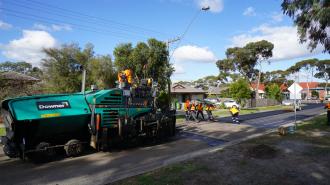Last year, China severed the world’s recycling pipeline.
Beijing’s “National Sword” initiative essentially banned the import of plastics and other recyclable materials into the country in 2018. Before the scabbard came off, China’s recycling plants handled almost half of the world’s plastic waste. Since then, plants have refused to take any waste that does not meet an almost impossible purity standard, and countries are now scrambling to dispose of recyclable materials in novel ways.
In some places, that means incineration; in others, it means infrastructure with recycled roads.
Paved with Plastics
Peter Tamblyn has not seen so much enthusiasm for recycling in his native Australia in the six decades of his life. Among the most optimistic about this new — and newly necessary — social shift is Close the Loop, an Australian-based multi-national whose mission is to foster a “circular economy” by developing sustainability programs and products. As the sales and marketing manager for Asian and Pacific markets at Close the Loop, Tamblyn’s job is to get one such recycled product, called TonerPlas, on the ground in as many places as possible.
A recycled road has been paved north of Melbourne with asphalt that contains the equivalent of hundreds of thousands of plastic bags, along with thousands of glass bottles and printer cartridges’ worth of waste toner. Those waste products were reduced down to their polymer forms and turned into pellets by Close the Loop. This recycled product is TonerPlas. An Australian infrastructure company, the Downer Group, uses the recycled plastic pellets to replace the virgin polymers, normally derived from oil, that bind asphalt’s rocky material together.
“It’s a way of using a lot of recycled material into a product which makes sense,” Tamblyn says.
In addition to the sheer amount of recycled materials the process will divert away from landfills, the roads provide other ecological advantages. According to Tamblyn, the TonerPlas-infused asphalt performs as well as most high-quality, premium asphalts, but at a much lower price.
These longer-lasting roads also help to reduce the carbon footprint of construction. According to Tamblyn, the impact has already been measured as more than a 30% reduction in emissions from the manufacturing of the road alone. The Downer Group came to that figure using a carbon footprint model that considered a myriad of factors, including using recycled materials, not needing to ship as many virgin materials, and the lower heat required to make TonerPlas.
And if these cheaper recycled roadways have the longer lifespans of higher-grade products, construction and maintenance costs may be reduced for the recycled road’s entire life, too.
The Cold Water
Despite being cheaper and having the Chinese pipeline cut off, there are challenges to making TonerPlas the industry standard.
TonerPlas roads have been laid outside Australia. In Kentucky, Lexmark — a longtime partner of Close the Loop that supplies their recyclable toner — used their own waste toner to pave a massive parking lot outside their R&D building. A stretch of road has been laid in Georgia, as well. But there’s a reason the American trial sites have been well south of the Mason-Dixon line: they do not do well in freezing temperatures.
“We need to make some adjustments to the type of polymers we put into our pellet, because you have that freeze/thaw situation,” Tamblyn says. That “situation” is not a common problem in Australia, but water will destroy asphalt when it gets inside the road, freezes, and expands. Icy wedges open up gaping holes seen on the streets of Chicago and other freeze-prone cities. Trials in the U.S. and U.K. are attempting to fix the problem. According to Tamblyn, progress has already been made.
Perceptions can be just as harsh as the weather. There is a public conception that recycled products are inferior to new ones. Close the Loop’s process essentially creates new polymers but from raw material made of recycled sources. Fears of microplastics being sprinkled into the roadway like Funfetti — Tamblyn likens it to more to dissolving sugar in coffee — cause concern as well. And engineers, who prefer products to be tried and true, may be reluctant to use a new material for so important a purpose without more proof of concept.
The Road Ahead
Tamblyn believes all these challenges can be surmounted, and he’s hopeful about the future of recycled waste in a way he has not been before.
“We’re much more resilient than we think we are,” Tamblyn says. He sees the Australian conversation about and investment in recycled materials as a step forward. A broad view of the world reveals not a collection of straight-line use of resources — done, dumped, and digging again — but a contained ecosystem of sustainability, a model for our own economic future.
“If we don’t go from linear to circular, we’re going to have a serious issue with resources,” Tamblyn says.
